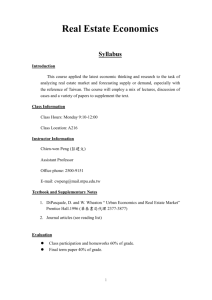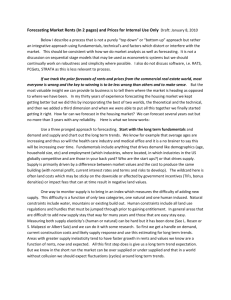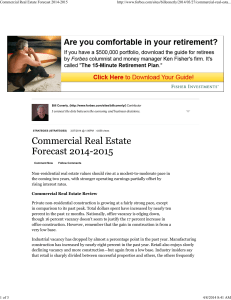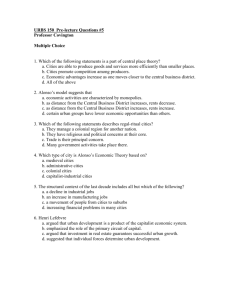State of the Commercial Real Estate Markets
advertisement
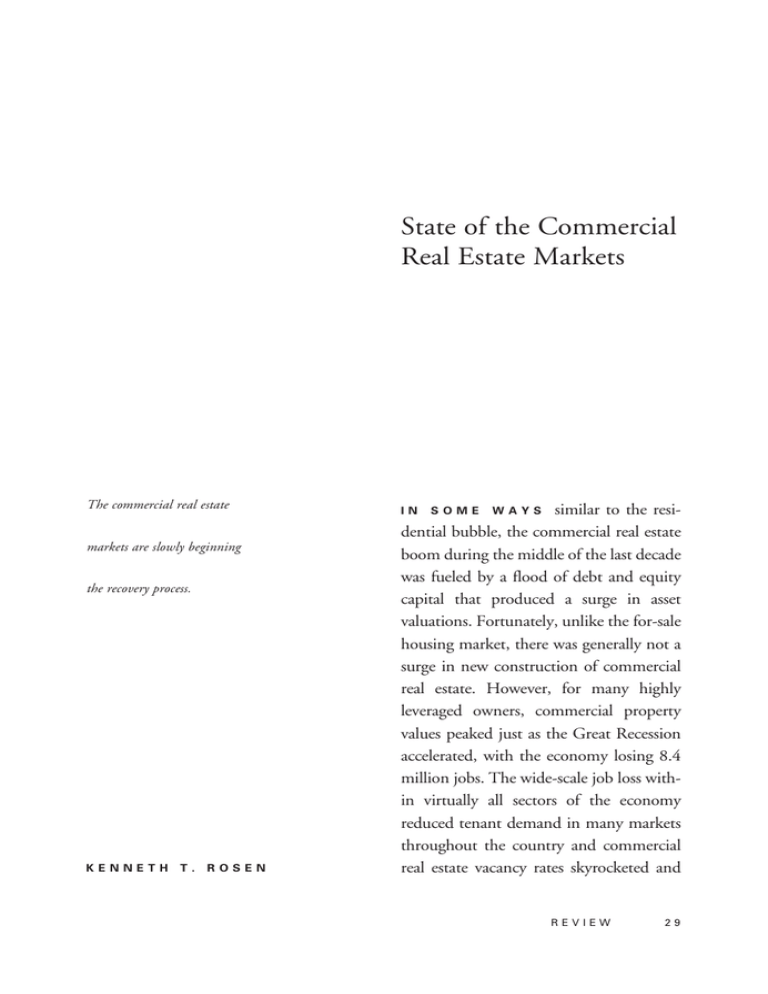
State of the Commercial Real Estate Markets The commercial real estate markets are slowly beginning the recovery process. KENNETH T. ROSEN S O M E W A Y S similar to the residential bubble, the commercial real estate boom during the middle of the last decade was fueled by a flood of debt and equity capital that produced a surge in asset valuations. Fortunately, unlike the for-sale housing market, there was generally not a surge in new construction of commercial real estate. However, for many highly leveraged owners, commercial property values peaked just as the Great Recession accelerated, with the economy losing 8.4 million jobs. The wide-scale job loss within virtually all sectors of the economy reduced tenant demand in many markets throughout the country and commercial real estate vacancy rates skyrocketed and IN REVIEW 29 rental rates plummeted as the recession deepened. The economic recovery has begun with the private sector adding 1.3 million jobs in 2010. We expect 1.8 million jobs to be added in 2011. This jobs recovery has shown up first in the rental apartment and the hotel markets. The office and industrial markets are lagging behind with an abundance of vacant space. This paper will examine the likely path of recovery of commercial real estate by sector. INVESTMENT MARKET From 2008 through 2009, the commercial real estate investment market was at a virtual standstill. As credit markets seized and the global recession deepened in 2008, commercial investment activity fell to $145.9 billion, a decrease of 71.6 percent from the previous year. In 2009, transaction volume plummeted to $54.4 billion, barely above 10 percent of the value of completed transactions that occurred two years prior. With few investors willing to step up because of questions regarding the accurate pricing of risk, real estate values plummeted. Estimates of value declines ranged from 25 percent to 50 percent depending upon location and property characteristics. In 2010, as signs of an economic recovery emerged and the capital markets opened dramatically, commercial real estate investment activity began to trend upward. During the recession, a large amount of opportunistic capital was raised and these funds were slowly $250 $600 $200 $500 $400 $150 $300 $100 $200 $50 $100 $0 $0 2001 2002 2003 2004 2005 2006 2007 2008 2010 Apartment (left-axis) Hotels (left-axis) Retail (left-axis) Industrial (left-axis) Office (left-axis) Total (right-axis) Note: Latest data year-to-date through November 2010. Source: Real Capital Analytics 30 2009 ZELL/LURIE REAL ESTATE CENTER Billions Billions Figure 1: Commercial real estate transaction volume deployed to resolve the growing number of distressed assets. Through the first eleven months of 2010, total transaction volume reached $101.1 billion, an increase of 85.9 percent from the previous annual total, according to Real Capital Analytics (Figure 1). Much of this increased sales volume was a result of the resolution of distressed properties. Private market real estate returns surged in 2010, reaching 10.8 percent annualized through the third quarter of 2010. The positive returns were driven by stabilized market conditions and realization that cap rates were driven too high in 2009. Through much of 2010, the apartment sector produced the greatest returns, reaching 15 percent by the third quarter. Going forward, commercial real estate values should continue to improve as mar- ket fundamentals fill up vacant space and effective rents begin to rise. The public real estate market rebounded significantly in 2010. The DJ Wilshire REIT Index appreciated by 28.6 percent in 2010, compared with 15.1 percent for the S&P 500, as REITs outperformed the broader stock market. The strength of the REIT market helped attract new equity issuance and initial public offerings (IPO) in 2010. Through the end of the year, completed IPOs totaled nearly $2 billion with several more firms in the various stages of the regulatory process (Figure 2). The commercial mortgage backed securities (CMBS) market began to emerge in 2010 from the depths of the credit crisis. New issuance increased to $11.6 billion in 2010 from $3.0 billion in 2009. Most banks have now reopened their CMBS Figure 2: Investment performance REITS vs. S&P 500 Index 40% Total Return 20% 0% -20% -40% 1992 1994 1996 1998 2000 DJ Wilshire REIT Index 2002 2004 2006 2008 2010 S&P 500 Index Latest data is as of January 18, 2011. Sources: S&P, Willshire Associates, RCG REVIEW 31 Figure 3: Domestic commercial MBS, gross amount issued $250 $230 $207 $200 $169 Billions $150 $93 $100 $78 $74 $59 $66 $49 $40 $50 $78 $29 $3 $8 $14 $17 $18 $18 $12 $3 $12 $0 1990 1992 1994 1996 1998 2000 2002 2004 2006 2008 2010 Note: Latest data year-to-date as of January 14, 2011. Source: Commercial Mortgage Alert Figure 4: Commercial mortgage maturities $250 Billions $200 $150 $100 $50 $0 1994 1996 1998 2000 2002 Banks 2004 CMBS 2006 2008 2010 Life Companies 2012 2014 2016 2018 2020 Other Sources: MBA, RCG windows and are actively originating new issuances. CMBS origination activity should accelerate in 2011, reaching approximately $40 billion this year (Figure 3). Though financing is once again available and investment is returning to the sector, a shortage of capital still exists for 32 assets outside of fully leased buildings in top-tier markets. Commercial real estate delinquencies rose further in 2010 as highly leveraged owners faced debt maturities and lower operating revenue. In the midst of the recession, many lenders opted to amend debt obligations rather than ZELL/LURIE REAL ESTATE CENTER Figure 5: Office construction value of construction put-in-place $100 $90 2005 Billions $80 $70 $60 $50 $40 $30 $20 $10 $0 1974 1977 1980 1983 1986 1989 1992 1995 1998 2001 2004 2007 2010 Note: Seasonally adjusted annual rate; latest data as of 3Q10. Sources: MBA, RCG seize properties in the negative operating environment. As operating conditions improve, some lenders will be more apt to repossess assets rather than extending terms. While many owners survived the downturn and remain on LIBOR life support, recapitalization is a primary goal going forward. It is likely that some operators will not be able to recapitalize, increasing the future volume of distressed assets. Also, it should be expected that some landlords will default as existing leases expire and space is marked to market as tenants renew or new leases are signed at lower rental rates. The rising tide of distressed properties and upcoming debt maturities will require a significant amount of debt and equity in order to recapitalize these portfolios (Figure 4). In recent quarters, investment capital was singularly focused on trophy assets and top-tier core market; however, with signs of a real estate recovery emerging and fears of a double-dip recession receding, investment interest is expanding to other strategies. With few trophy properties available, and those that are marketed typically receive multiple bids, some investors are turning to secondary markets or are increasingly willing to undertake vacancy risk in search of higher yields. OFFICE MARKET The Great Recession took a significant toll on the national office market, with a large amount of space vacated by tenants in the finance and real estate industries. As the recession worsened, mass layoffs and office closures occurred throughout the spectrum of office-using employment REVIEW 33 Figure 6: Office vacancy rates downtown and suburban 30% 25% 20% 15% 10% 5% 0% 1984 1986 1988 1990 1992 1994 1996 1998 Downtown 2000 2002 2004 2006 2008 2010 Suburban Note: Latest data as of 3Q10. Sources: C&W, RCG sectors. In 2008 and 2009, more than 2.3 million office-using jobs were eliminated. As firms closed their doors and returned space to the market, the office vacancy rate spiked to 17.7 percent in 2009, a 5.1 percentage point increase from year-end 2007. Preventing an even larger increase in the amount of vacant space, developers quickly closed the construction pipeline. In 2007, private put-in-place construction totaled $44.9 billion and quickly fell to $31.1 billion by the end of 2009 (Figure 5). It should be noted that the majority of new supply was delivered within suburban submarkets rather than CBDs. The quick reaction of developers, as well as relative restraint during the pre-recession period due to high construction costs, meant that the office market would not suffer from the double-barrel effects of a demand 34 drop-off and oversupply as occurred in the early 1990s recession. Leasing market fundamentals bottomed by the middle of 2010 in many markets. As economic conditions improved and business confidence stabilized, some signs of improvement appeared in several prime office markets. By the second half of 2010, the national vacancy rate stabilized at slightly below 18.0 percent as leasing activity increased to more than 162.5 million square feet through the first three quarters of the year. Within trophy assets in gateway cities, the combination of lower rents and economic recovery coupled to create a significant flight-to-quality phenomenon, which in turn prompted some landlords to reverse field and increase asking rents in markets such as Manhattan, San Francisco and Washington, D.C. Conversely, com- ZELL/LURIE REAL ESTATE CENTER Figure 7: Industrial warehouse construction value of construction put-in-place $35 $30 2005 Billions $25 $20 $15 $10 $5 $0 1980 1983 1986 1989 1992 1995 1998 2001 2004 2007 2010 Note: Seasonally adjusted annual rate; latest data as of 3Q10. Sources: Census, RCG modity space and properties within tertiary markets or on the outskirts of the suburbs continued to exhibit high vacancy rates and declining rents (Figure 6). Although tenant activity is on the path to recovery, developers remain on the sidelines, both by choice and by necessity because of the restrictive lending environment. With a multitude of space options available in most markets, achievable rents have yet to reach a level required to make new construction a reality. In fact, with continued economic uncertainty and limited availability of construction financing, put-in-place construction fell to nearly $18.8 billion by the third quarter of 2010. Moving forward, the office market should continue to recover from the recession. Economic expansion in the near term should create new jobs within office-using sectors, but this will have a minimal effect on occupied office space as most new hires will be housed in underutilized space. For the next several quarters, tenants are likely to hold leverage during lease negotiations though landlords have already begun to limit the value of concession packages in recent months. As vacant space is absorbed, asking rental rates should appreciate at a slow pace. With expectations for a quick turnaround in leasing demand low, the likelihood of a substantial increase in construction activity within the next two years is minimal. INDUSTRIAL MARKET Through the recession, the national industrial market weakened quickly and considerably as manufacturing output REVIEW 35 Figure 8: Industrial vacancy rate 12% 10% 8% 6% 4% 2% 0% 1980 1983 1986 1989 1992 1995 1998 2001 2004 2007 2010 Note: Latest data as of 3Q10. Sources: CB Richard Ellis, RCG plummeted and global cargo movement dropped dramatically. In 2009, more than 1.96 million manufacturing, transportation and wholesale trade jobs were lost. Not only did mass layoffs increase, but production slowed at manufacturing plants throughout the country as lines were idled or shifts eliminated. Industrial capacity utilization fell to a low of 68.2 percent in mid-2009, 15.5 percent lower than the long-term average utilization rate of 80.6 percent. By the end of 2009, the industrial vacancy rate spiked to 10.4 percent and the average asking rent fell by 21.9 percent during the year. The relatively short build time for industrial properties proved to be a positive for the sector as the development pipeline quickly shut down and private put-inplace construction totaled just $7.1 bil- 36 lion in 2009, a decrease of 42.7 percent from the previous year (Figure 7). As economic conditions began to improve in 2010, the industrial market stabilized somewhat. The vacancy rate held steady at the mid-10 percent level; however, with fewer active tenants in the market, landlords continued to reduce asking rents (Figure 8). Through the first three quarters of the year, the average asking rent was 6.3 percent lower than in 2009. In several local markets, rents have begun to stabilize and some landlords are already curtailing leasing concessions; however, generally speaking tenants are still able to negotiate for free rent, sizable tenant improvement allowances and other incentives. Financially secure tenants have begun to take advantage of economical rental rates and upgrade space ZELL/LURIE REAL ESTATE CENTER or relocate to more accessible submarkets. State-of-the-art distribution facilities are now experiencing a significant increase in space demand. The recovery also began in port-adjacent markets. Although tenant demand is on the rise, construction activity will not mirror this trend. Through the third quarter, annualized put-in-place construction totaled $3.5 billion, an alltime low after adjusting for inflation. The recovery within the national industrial market should continue in the near term, helped by the lack of new industrial product. Business and consumer expenditures should increase in the near term, driving a recovery of some of the wholesale trade and logistics jobs that were eliminated during the recession. While the demand for quality distribution space is on the rise, a rapid increase in the occupancy rate is not expected, particularly as many retailers and suppliers learned to operate at very lean levels in order to survive the recession. Tenant and user demand should be greatest within primary distribution markets and locations close to deepwater ports or with access to transportation infrastructure. Shifts in supply chain management are likely to focus on fewer facilities located in gateway markets rather than multiple operations in secondary and tertiary markets, highlighting just-in-time techniques and moving away from the “just-in-case” philosophies that were developed prior to the recent reces- sion. The slow absorption of space should prevent a significant spike in rental rates, with perhaps the exception being state-ofthe-art warehouses near major ports. New construction activity will remain minimal through 2011, producing the lowest amount of new product in decades. RETAIL MARKET The Great Recession took a significant toll on consumers, with job losses and declines in net worth leading to a plummet in consumer confidence and retail sales. In one of the largest surprises of the recession, the sharp drop in retail receipts led to a smaller-than-expected number of store closings. While many retailers were driven out of business and numerous storefronts went dark, the retail vacancy rate did not break the 9 percent threshold through 2009. In comparison, the national retail vacancy rate exceeded 12 percent following the early-1990s recession. Many of the big-box vacancies created by bankrupt retailers at the onset of the recession have already been filled by new tenants. Although new leasing demand remained relatively weak, the average rental rates for neighborhood strip centers, power centers and regional malls were flat throughout the recession. In contrast, operating income shrunk considerably as some landlords offered discounts or rent abatements to REVIEW 37 Figure 9: Retail construction value of construction put-in-place $70 $60 2005 Billions $50 $40 $30 $20 $10 $0 1980 1983 1986 1989 1992 1995 1998 2001 2004 2007 2010 Note: Seasonally adjusted annual rate; latest data as of 3Q10. Sources: Census, RCG Figure 10: Real retail sales growth excluding autos 8% 6% 4% 2% 0% -2% -4% -6% -8% -10% 1982 1986 1990 1994 1998 2002 2006 2010 Note: Annual change; latest data as of 3Q10. Source: Census existing tenants and received less income from percentage rents. The credit market seizure and weak leasing environment curtailed new construction activity in time to prevent a severe oversupply situation. By 38 2009, put-in-place construction totaled just $24.6 billion, approximately half of the value in 2007 (Figure 9). In 2010, the retail market began to stabilize. Rising consumer confidence in the ZELL/LURIE REAL ESTATE CENTER first half of the year provided a substantial boost to retailers, slowing the pace of store closings significantly. While vacant shop space is still on the rise, the bulk of new store closings are from “mom and pop” stores or smaller chains rather than the national chain stores that were the source of vacancy early in the recession. Same store sales growth began to recover more quickly in 2010 and the holiday season was the best since 2007 (Figure 10). The lack of new development activity was one of the biggest positives in the past year, helping to restrain the vacancy rate from spiking higher. Many developers quickly stopped construction activity even on in-progress shopping centers. With the rising tide of newly vacated space slowing, rents stabilized and exhibited some appreciation in the neighborhood center and regional mall categories. Continued job growth, rising consumer confidence and improved retailer health should contribute to a stronger demand for space in the near term. The strengthening conditions should contribute to a lower vacancy rate and rental rate appreciation across nearly all retail property types (Figure 11). Expectations for the retail market should be tempered as the unemployment rate will remain elevated for the next several years. Additionally, the savings rate is expected to be higher than in recent years as households rebuild their balance sheets. With limited access to credit and relatively slow income growth, consumer spending will be constrained throughout the initial years of the economic recovery. Consequently, most retailers will be cautious in their expansion plans and this will lead to a slower recovery in the retail property market than in previ- Figure 11: Retail vacancy rate 14% 12% 10% 8% 6% 4% 2% 0% 1980 1983 1986 1989 1992 1995 1998 2001 2004 2007 2010e Note: Latest data is 2010 forecast. Sources: Valuation International, Viewpoint, SNL, RCG REVIEW 39 ous recessions. With space demand from new stores limited, construction activity should remain extremely low relative to the historical average. MULTIFAMILY MARKET The apartment market was the best performing real estate sector through the recession. Although job losses caused many households to double-up or into other shared living arrangements, the foreclosure crisis reduced the homeownership rate and added to the pool of potential renters. In 2009, the Census rental vacancy rate increased to 10.6 percent, only 90 basis points higher than the recent low in 2006. For investmentgrade apartment properties, the vacancy rate peaked at 8.2 percent in the fourth quarter of 2009, on par with the peak levels of recent recessions. The lower occupancy rates translated into reduced rents for existing tenants and available units. In 2009, the average rent within professionally managed apartment properties fell 4.1 percent, according to MP/F Research. Although operating conditions were weak through the recession, a limited amount of construction did occur. In 2009, multifamily rental starts totaled 91,000 units, less than half of the rental starts in 2008 (Figure 12). In 2010, multifamily market conditions improved dramatically as job growth and household formation rebounded. The higher level of job security among the employed and with new supply relatively constrained throughout the recession produced occupancy and net income gains in 2010. By the third quarter, the Census Figure 12: Multifamily rental housing starts 300 250 Units, Thous. 200 150 100 50 0 1994 1996 1998 2000 2002 Note: Latest data is annualized as of 3Q10. Sources: Census, RCG 40 ZELL/LURIE REAL ESTATE CENTER 2004 2006 2008 2010 Figure 13: Rental apartment vacancy rate 14% 12% 10% 8% 6% 4% 2% 0% 1992 1994 1996 1998 2000 2002 Census Vacancy Rate (5+ Units) 2004 2006 2008 2010 MP/F Investment Grade Vacancy Rate Note: Latest data as of 3Q10. Sources: Census, NMHC Figure 14: Rental apartment inflation 12% 10% 8% 6% 4% 2% 0% -2% -4% -6% 1994 1996 1998 2000 CPI Rental Component 2002 2004 2006 2008 2010 Professionally Managed Apartments Note: Annual change; Latest data as of 3Q10. Sources: BLS, NMHC rental vacancy rate fell to 10.3 percent. Investment-grade properties displayed a greater improvement, with the vacancy rate falling to 6.2 percent in the third quarter (Figure 13). The increased demand within professionally managed apartments led to a 1.2 percent year-over-year increase in rents. The improved leasing conditions in 2010 led to further new development activity, which classified the apartment REVIEW 41 Figure 15: Hotel construction value of construction put-in-place $35 $30 2005 Billions $25 $20 $15 $10 $5 $0 1980 1983 1986 1989 1992 1995 1998 2001 2004 2007 2010 Note: Seasonally adjusted annual rate; latest data as of 3Q10. Sources: Census, RCG sector as the only real estate property type to produce an increase in activity in 2010. Annualized through the third quarter, rental housing starts should reach 104,000 units, an increase of 14.3 percent from the previous year. As the economic recovery strengthens, job creation will further unbundle households and expand tenant demand. The number of vacant units should decrease steadily through the next several years as not only will the newly employed rent units but also many renters will stay in apartments for an extended period rather than shifting to homeownership. The increasing occupancy levels will provide landlords with sufficient leverage to raise rents substantially during the medium term (Figure 14). The positive outlook for operating conditions, combined with relatively available and affordable capi- 42 tal, will prompt an increase in construction activity for rental apartments. LODGING MARKET The national hotel market was the worst performing sector in the midst of the recession, but began to rebound substantially in 2010. In 2009, the occupancy rate plummeted to 55.1 percent, the lowest rate in more than 20 years. With so many vacancies, revenue per available room (RevPAR) fell by 16.7 percent, according to Smith Travel Research. While construction activity peaked in 2008, leading to oversupply conditions particularly in the extended stay segment and along interstate highways, by 2009 put-in-place construction fell to $20.7 billion (Figure 15). ZELL/LURIE REAL ESTATE CENTER Figure 16: Hotel occupancy rate 70% 65% 65% 66% 65% 64% 64% 63% 62% 66% 62% 63% 63% 64% 63% 62% 63% 61% 61% 60% 60% 60% 59% 59% 59% 55% 55% 50% 1988 1990 1992 1994 1996 1998 2000 2002 2004 2006 2008 2010 2006 2008 2010 Note: Latest data year-to-date as of November 2010. Sources: Smith Travel Research, RCG Figure 17: RevPAR growth 15% 10% 5% 0% -5% -10% -15% -20% 1988 1990 1992 1994 1996 1998 2000 2002 2004 Note: Latest data year-to-date as of November 2010. Sources: Smith Travel Research, RCG The burgeoning economic recovery spurred business travel activity and increased consumer confidence prompted an uptick in leisure travel. Travel activity has rebounded following the sharp drop-off during the recession, though travelers continue to be bargain-conscious. In recent months, many hotel chains produced strengthened operating results. By the third quarter of 2010, the occupancy rate increased to 58.9 per- REVIEW 43 cent, with even better results within urban destination markets (Figure 16). RevPAR increased 4.5 percent through the third quarter, led by a strong rebound in the luxury hotel segment (Figure 17). Although operating performance improved, developers are still hesitant to build and financing is difficult to obtain. In 2010, an under construction hotel was a rare sight, with only $8.7 billion of annualized put-in-place construction through the third quarter. The occupancy rate should continue on an upward trajectory through the next year and the average daily room rate will also trend upward. RevPAR growth should accelerate, increasing at a faster pace in the next four years. A strong investor preference for core assets in gateway markets should continue as risk appetites adjust, though secondary markets and slightly riskier strategies will increase as investors seek higher yield opportunities. CONCLUSION The commercial real estate markets are slowly beginning the recovery process. The general trend should continue on an upward trajectory. In the near term, the demand recovery will continue as job growth accelerates. Achievable rental rates will appreciate at a measured pace and it is unlikely that there will be a significant rent spike, with the exception of rental apartments, until much of the vacant space is absorbed. The slow recovery in tenant demand will constrain construction activity for at least the next two years, again with the exception of a likely surge in new apartment construction. 44 ZELL/LURIE REAL ESTATE CENTER
